1. Korean National Statistical Office. Annual Report on Cause of Death Statistics. Daejeon: Korean National Statistical Office;2020.
2. Lee JY, Choi SK, Seo JS. Evaluation of the nutrition status and metabolic syndrome prevalence of the members according to the number of household members based on the Korea National Health and Nutrition Examination Survey (2013–2014). Korean J Community Nutr. 2019; 24:232–244.
3. Hu EA, Steffen LM, Coresh J, Appel LJ, Rebholz CM. Adherence to the Healthy Eating Index-2015 and other dietary patterns may reduce risk of cardiovascular disease, cardiovascular mortality, and all-cause mortality. J Nutr. 2020; 150:312–321. PMID:
31529069.
4. Lafrenière J, Carbonneau É, Laramée C, Corneau L, Robitaille J, Labonté ME, Lamarche B, Lemieux S. Is the Canadian Healthy Eating Index 2007 an appropriate diet indicator of metabolic health? Insights from dietary pattern analysis in the PREDISE study. Nutrients. 2019; 11:1597. PMID:
31337138.
5. Grech A, Sui Z, Siu HY, Zheng M, Allman-Farinelli M, Rangan A. Socio-demographic determinants of diet quality in Australian adults using the validated Healthy Eating Index for Australian adults (HEIFA-2013). Healthcare (Basel). 2017; 5:7. PMID:
28165394.
6. Peltner J, Thiele S. Association between the Healthy Eating Index-2010 and nutrient and energy densities of German households’ food purchases. Eur J Public Health. 2017; 27:547–552. PMID:
28073813.
7. Panizza CE, Shvetsov YB, Harmon BE, Wilkens LR, Le Marchand L, Haiman C, Reedy J, Boushey CJ. Testing the predictive validity of the healthy eating Index-2015 in the multiethnic cohort: is the score associated with a reduced risk of all-cause and cause-specific mortality? Nutrients. 2018; 10:E452.
8. Fogli-Cawley JJ, Dwyer JT, Saltzman E, McCullough ML, Troy LM, Meigs JB, Jacques PF. The 2005 Dietary Guidelines for Americans and risk of the metabolic syndrome. Am J Clin Nutr. 2007; 86:1193–1201. PMID:
17921402.
9. Kesse-Guyot E, Ahluwalia N, Lassale C, Hercberg S, Fezeu L, Lairon D. Adherence to Mediterranean diet reduces the risk of metabolic syndrome: a 6-year prospective study. Nutr Metab Cardiovasc Dis. 2013; 23:677–683. PMID:
22633793.
10. Statistics Korea [Internet]. Daejeon: Statistics Korea;2022. Available from:
www.kostat.go.kr.
12. Jung KH, Nam SH, Jung EJ, Lee JH, Lee YK, Kim JS, Kim HY, Jin MJ. Policy implications of changes in family structure: focused on the increase of single person households in Korea. Sejong: Korea Institute for Health and Social Affairs;2012.
13. Byun M. Single person household and urban policy in Seoul. Korean J Cult Soc Issues. 2015; 21:551–573.
14. Kim HY. Floating families in Korea: focusing on one-person households. J Korean Soc Res. 2014; 15:255–292.
15. Sellaeg K, Chapman GE. Masculinity and food ideals of men who live alone. Appetite. 2008; 51:120–128. PMID:
18343534.
16. Udell JA, Steg PG, Scirica BM, Smith SC Jr, Ohman EM, Eagle KA, Goto S, Cho JI, Bhatt DL. REduction of Atherothrombosis for Continued Health (REACH) Registry Investigators. Living alone and cardiovascular risk in outpatients at risk of or with atherothrombosis. Arch Intern Med. 2012; 172:1086–1095. PMID:
22711020.
17. Lidfeldt J, Nerbrand C, Samsioe G, Agardh CD. Women living alone have an increased risk to develop diabetes, which is explained mainly by lifestyle factors. Diabetes Care. 2005; 28:2531–2536. PMID:
16186292.
18. Kharicha K, Iliffe S, Harari D, Swift C, Gillmann G, Stuck AE. Health risk appraisal in older people 1: are older people living alone an “at-risk” group? Br J Gen Pract. 2007; 57:271–276. PMID:
17394729.
19. Quandt SA, McDonald J, Arcury TA, Bell RA, Vitolins MZ. Nutritional self-management of elderly widows in rural communities. Gerontologist. 2000; 40:86–96. PMID:
10750316.
20. Sidenvall B, Nydahl M, Fjellstrom C. Managing food shopping and cooking: the experiences of older Swedish women. Ageing Soc. 2001; 21:151–168.
21. Sidenvall B, Nydahl M, Fjellström C. The meal as a gift – the meaning of cooking among retired women. J Appl Gerontol. 2000; 19:405–423.
22. Wham CA, Bowden JA. Eating for health: perspectives of older men who live alone. Nutr Diet. 2011; 68:221–226.
23. Kweon S, Kim Y, Jang MJ, Kim Y, Kim K, Choi S, Chun C, Khang YH, Oh K. Data resource profile: the Korea National Health and Nutrition Examination Survey (KNHANES). Int J Epidemiol. 2014; 43:69–77. PMID:
24585853.
24. Willett W. Nutritional Epidemiology. 3rd ed. New York (NY): Oxford University Press;2013.
25. World Health Organization. The Asia-Pacific Perspective: Redefining Obesity and Its Treatment. Brussels: International Obesity Task Force, World Health Organization;2000.
26. Korea Centers for Disease Control and Prevention. Guide to the Utilization of the Data from the Seventh Korean National Health and Nutrition Examination Survey (KNHANES VII). Cheongju: Korea Centers for Disease Control and Prevention;2020.
27. National Rural Resources Development Institute. Korean Food Composition Table. 8th ed. Suwon: Rural Development Administration;2011.
28. Yook SM, Park S, Moon HK, Kim K, Shim JE, Hwang JY. Development of Korean Healthy Eating Index for adults using the Korea National Health and Nutrition Examination Survey data. J Nutr Health. 2015; 48:419–428.
29. Burns C, Bentley R, Thornton L, Kavanagh A. Reduced food access due to a lack of money, inability to lift and lack of access to a car for food shopping: a multilevel study in Melbourne, Victoria. Public Health Nutr. 2011; 14:1017–1023. PMID:
21338555.
30. Coleman-Jensen AJ. Working for peanuts: nonstandard work and food insecurity across household structure. J Fam Econ Issues. 2011; 32:84–97.
31. Duerr L. Food security status of older adult home-delivered meals program participants and components of its measurement. J Nutr Elder. 2006; 26:1–26. PMID:
17890201.
32. Lee JS, Frongillo EA Jr. Factors associated with food insecurity among U.S. elderly persons: importance of functional impairments. J Gerontol B Psychol Sci Soc Sci. 2001; 56:S94–S99. PMID:
11245369.
33. Quine S, Morrell S. Food insecurity in community-dwelling older Australians. Public Health Nutr. 2006; 9:219–224. PMID:
16571176.
34. GBD 2017 Diet Collaborators. Health effects of dietary risks in 195 countries, 1990-2017: a systematic analysis for the Global Burden of Disease Study 2017. Lancet. 2019; 393:1958–1972. PMID:
30954305.
35. Neelakantan N, Koh WP, Yuan JM, van Dam RM. Diet-quality indexes are associated with a lower risk of cardiovascular, respiratory, and all-cause mortality among Chinese adults. J Nutr. 2018; 148:1323–1332. PMID:
29982724.
36. Lee E. Relationship between household types, health-related lifestyle, health service usage, and health outcomes across age groups. Korean J Health Educ Promot. 2021; 38:1–12.
37. Lee H, Cho YT. Comparison of health behaviors, disease prevalence between middle aged one-person households and multi-member households in South Korea. Health Soc Welf Rev. 2019; 39:380–407.
38. Shin SR, Lee SM. Relation between the total diet quality based on Korean Healthy Eating Index and the incidence of metabolic syndrome constituents and metabolic syndrome among a prospective cohort of Korean adults. Korean J Community Nutr. 2020; 25:61–70.
39. Rashidipour-Fard N, Karimi M, Saraf-Bank S, Baghaei MH, Haghighatdoost F, Azadbakht L. Healthy eating index and cardiovascular risk factors among Iranian elderly individuals. ARYA Atheroscler. 2017; 13:56–65. PMID:
29026411.
40. Nicklas TA, O’Neil CE, Fulgoni VL 3rd. Diet quality is inversely related to cardiovascular risk factors in adults. J Nutr. 2012; 142:2112–2118. PMID:
23077187.
41. Park S, Kim K, Lee BK, Ahn J. Association of the Healthy Eating Index with estimated cardiovascular age in adults from the KNHANES 2013-2017. Nutrients. 2020; 12:2912. PMID:
32977614.
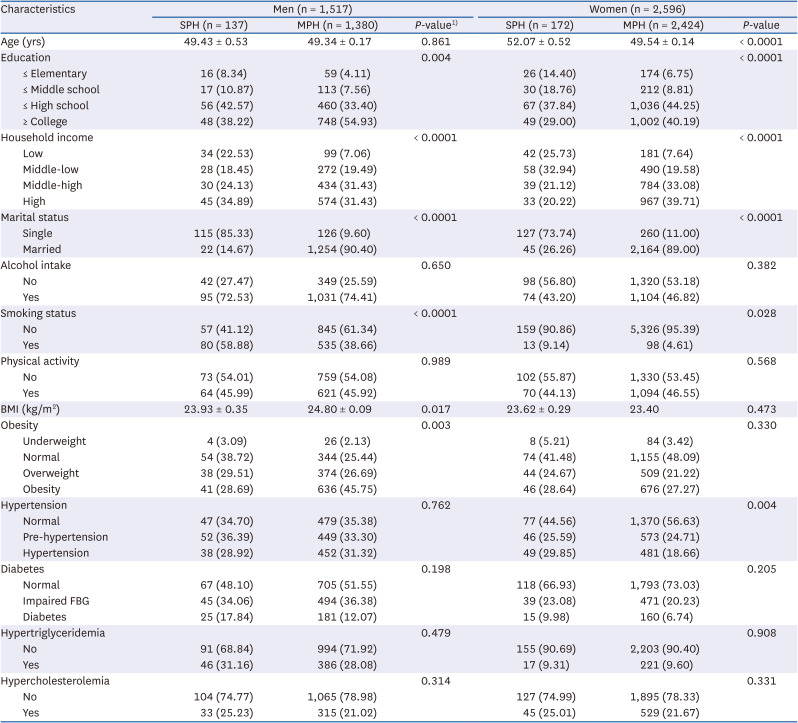

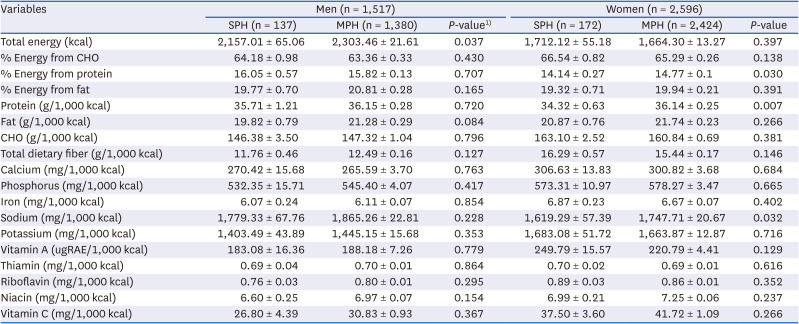
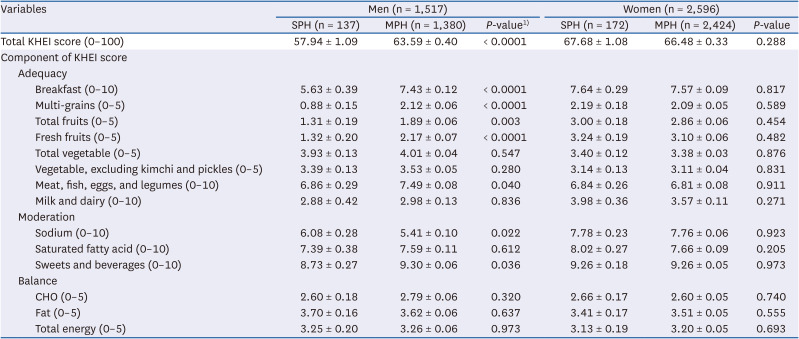
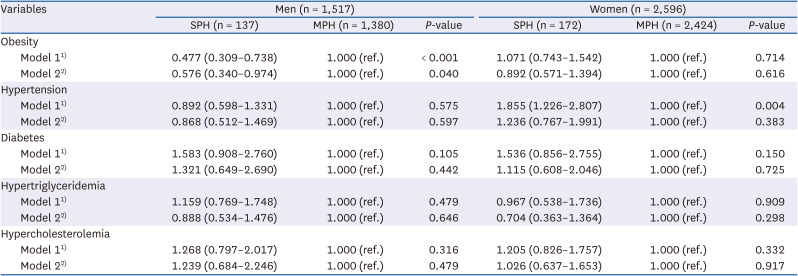
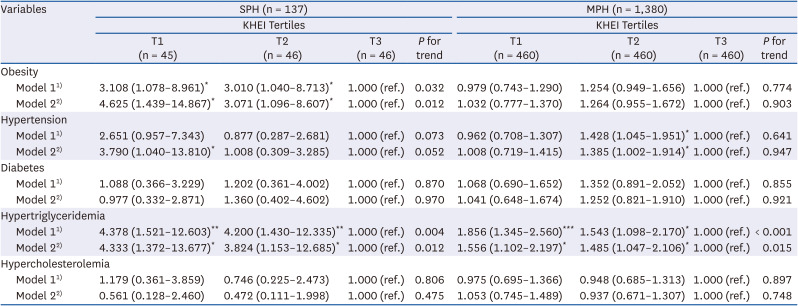
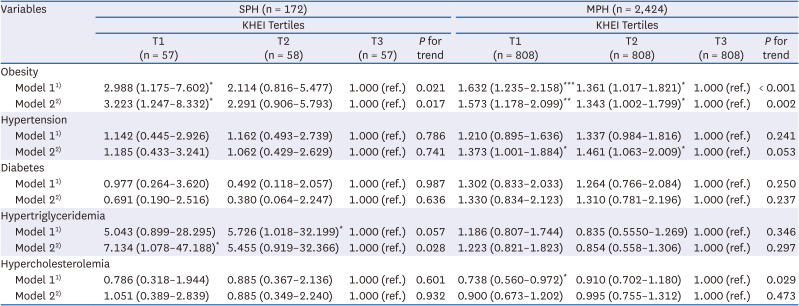




 PDF
PDF Citation
Citation Print
Print



 XML Download
XML Download